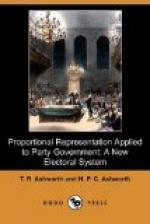+The Hare System is not Preferential.+—The idea is sedulously fostered that the Hare system is a form of preferential voting, and many people are misled thereby. The act of voting is exalted into an end in itself. The most elaborate provisions are now suggested by Professor Nanson to allow the elector to express his opinion only as far as he likes. The simple and practical method in use in Tasmania of requiring each elector to place a definite number of candidates in order of preference is denounced as an infringement of the elector’s freedom. Why force him to express preferences where he does not feel any? The Professor has therefore invented “the principle of the bracket.” If the elector cannot discriminate between the merits of a number of candidates he may bracket them all equal in order of favour. Indeed, where he does not indicate any preference at all, the names unmarked are deemed equal. Therefore, if he does not wish his vote transferred to any candidate, he must strike out his name. It is pointed out that a ballot paper can thus be used if there is any kind of preference expressed at all, and the risk of informality is reduced to a minimum. All the bracket papers are to be put into a separate parcel, and do not become “definite” till all the candidates bracketed, except one, are either elected or rejected; the vote is then transferred to that candidate. And as bracketed candidates will occur in original papers, surplus papers, and excluded candidates’ papers at every stage of the count, the degree of complication in store for the unhappy returning officer can be imagined.




